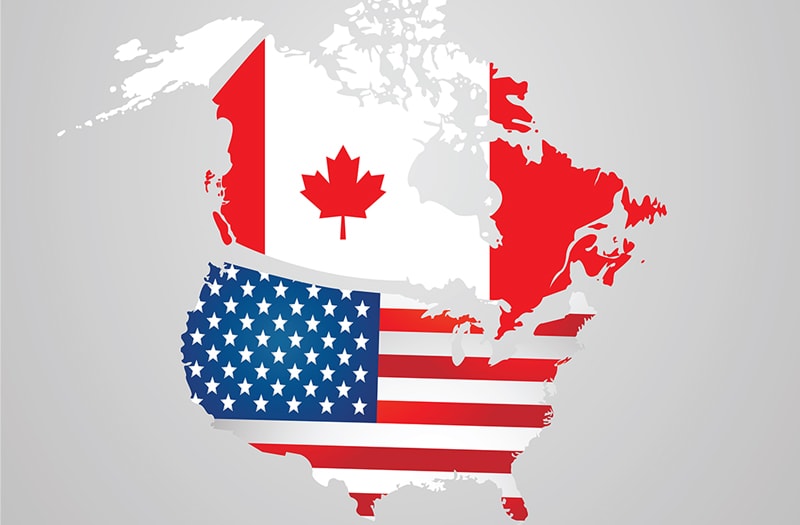Canada & the United States: Mapping Out Cross-Border Connections

The strength of the trade relationship between the neighboring countries is illustrated daily in border crossings, where freight handled by experienced logistics providers moves seamlessly both ways.
Canada and the United States are joined at the hip—geographically, culturally, and economically. And in remarks to the Canadian Parliament in spring 2023, U.S. President Joe Biden went even further than that. “Americans and Canadians are two people, two countries, in my view, sharing one heart,” he said.
Canada, Mexico, and China are the United States’ top three trading partners. Measured by logistics alone, however, the American relationship with Canada enjoys a status all its own.
“Canada and the United States share the longest land border in the world,” Canadian Prime Minister Justin Trudeau said in remarks following Biden’s address to Parliament. “We share three oceans and the Great Lakes.”
Intertwined and Inseparable
Those geographical links and the longstanding friendship between the two countries translate into a uniquely cooperative experience in border crossings—for both freight and people. Just ask vacationing Americans who cross from Niagara Falls, New York, to Niagara Falls, Ontario, and back again with ease.
Likewise, logistics providers on both sides of the Canada-U.S. border attest to the relatively seamless nature of the customs procedure as products move between the countries.
Logistics companies and shippers that have experience with, and knowledge of, the rules and regulations governing the process are routinely on top of any changes and adjustments in real time.
No wonder. The two countries are more than mere neighbors and friends. President Biden puts it this way: “Our destinies are intertwined and they’re inseparable.”
All indications point to a bond that is not going to change anytime soon. Trudeau puts it this way: “Whether it’s protecting our shared waters, including in the Arctic, conserving biodiversity, or building strong net-zero economies, Canada and the United States will continue to work together as partners.”
The partnership between the two countries is especially strong in commerce and trade. Biden has said the United States has no closer friend or ally than Canada. Nearly $2.6 billion in goods and services crossed the shared border every day in 2022, an almost 20% increase over the previous year.
This trade is vital to the economies of both countries, supporting millions of jobs on both sides of the border.
Keys to Strengthening the Partnership
Both countries strive to keep border crossings as smooth and efficient as possible. To that end, both governments established the U.S.-Canada Supply Chain Working Group to support the “Roadmap for a Renewed U.S.-Canada Partnership,” a blueprint created in 2021 to strengthen U.S.-Canada supply chain security and to “reinforce the deeply interconnected and mutually beneficial economic relationship between our two countries.”
In a joint statement, Biden and Trudeau explained: “It creates a partnership on climate change, advances global health security, bolsters cooperation on defense and security, and reaffirms a shared commitment to diversity, equity, and justice. Bound by history and geography, the partnership between the United States and Canada endures because we invest in each other’s success.”
The Supply Chain Working Group focuses on enhancing cooperation in key areas, including trade, with the objective of reaching greater alignment and identifying potential vulnerabilities.
The Working Group has initiated a Joint Economic Analysis to map supply chains and explore issues such as skills development and regulatory cooperation.
In 2021, the White House announced the creation of the Supply Chain Disruptions Task Force to address pandemic-era road and rail bottlenecks around borders and major ports. Among other things, the task force has worked to increase digital information flow between private companies operating logistics supply chains.
Meanwhile, Canada established its own Supply Chain Task Force to solicit recommendations regarding short- and long-term solutions to supply chain challenges from industry experts, businesses, and workers.
The result of all this has been the establishment and, when necessary, adjustment of requirements that enable manufacturers and shippers to comply with regulations free of undue stress—so long as the companies making the actual crossings are sufficiently prepared.
U.S.- and Canada-based logistics providers with rich experience in border crossings, such as FLS Transportation and Polaris Transportation Group, stand ready to provide those services.

Polaris Transportation Group has been known for its scheduled LTL service between Canada and the United States since 1994. The company now offers complete supply chain management for shippers, from transportation services to warehousing to digital solutions.
Forging Ahead
The pandemic served to underline, strengthen, and illuminate the mutually beneficial trade relationship between the United States and Canada. And in the aftermath of the pandemic, that relationship is more important than ever.
“We’ve seen a lot more business repatriated to North America,” explains Dave Cox, president of Polaris Transportation Group, a Toronto area-based industry leader in transit to and from the United States.
While driving on a business trip from Polaris headquarters just outside Toronto in Mississauga, Ontario, to the Cleveland suburb of Mentor, Ohio, Cox reflects on how the bonds between the North American neighbors grow year after year, through all challenges and changes.
“To me, as an entrepreneur and a business owner, these are exciting times,” he says. “These past three years have reinforced our ability to manage in a way that drives the Polaris culture of close connections with our teams. The pandemic caused us to strengthen our relationships through deeper conversations with our customers and partners.”
Pandemic-induced supply chain disruptions prompted collaborative efforts—always a hallmark of North American cross-border trade relationships—to increase, Cox notes.
“Carriers need strong relations with manufacturers and distributors,” he says. “These conversations are important. If I were a shipper, I would want to know I have a friend out there. We want shippers and distributors to think of us as good friends.”
Communication takes place at all levels, from sales to the C-suite, because Canada is mindful that as much as the United States depends on Canada, the reverse is likewise true. “We’re a trading nation,” he says of Canada. “Our standard of living depends on close ties to the United States.”
A Digital Passport for Freight
The heightened interdependence of the border-sharing neighbors presents an opportunity to build on their physical connections, Cox notes.
“I would like to see stronger efforts to streamline trade between Canada, the United States, and Mexico,” he says, adding he envisions a “trade union” where goods flow freely among the North American nations, as they do in the European Union.
“We have a fantastic opportunity,” he says. “Why not a digital passport for freight?”
As he sees it, a “digital passport” would function as something of a freight counterpart to the TSA PreCheck for airline passengers. Prior clearance through government oversight departments on both sides of the border—such as the Canada Border Services Agency in Canada and the Food and Drug Administration and Department of Agriculture in the United States—would serve to make the process of border crossings for freight more efficient and stress-free.
“At Polaris, we make it a point to know those agencies,” he says. “Wouldn’t it be wonderful if we had complete compliance already established? We know what we have to do on a daily basis and we’re very good at it.”
While recognizing and appreciating the relative speed and proficiency of border crossings handled by experienced logistics providers like Polaris, Cox says he believes there is always room for improvement.
“Business is coming back to North America,” he says. “So let’s make trade easy.”

FLS Transportation maximizes the benefits of cross-border trade between the United States and Canada by leveraging advanced technology and artificial intelligence systems. The team uses tracking and visibility tools to offer real-time shipping updates and enhance collaboration.
Knowledge Is Power
Giles Moore, the director of strategic accounts for FLS Transportation, also shares insights on the state of post-pandemic cross-border shipping.
While shipping volumes have remained strong, they have also stayed stagnant, he notes. Moore attributes this to the expected geographic differences between the two countries, leading to an imbalance between north and southbound volumes.
FLS Transportation, based in Atlanta, Georgia, with 17 offices throughout North America, specializes in cross-border third-party logistics (3PL) services. In addition to its expertise in over-the-road transport, the company offers customizable contract logistics functions such as warehousing, cross-docking, project logistics, and freight management.
Moore highlights the demand for Canada-specific providers due to the unique challenges of the Canadian market. Cross-border prices are more volatile compared to the domestic market, he notes.
Despite the challenges, the post-pandemic market has experienced double-digit growth, he states.
The recent scene of container ships waiting at major ports has emphasized North America’s reliance on Asian imports. As a result, many top companies have brought their operations and supply chain volumes back onshore, leading to an increased role for Mexico in the USMCA relationship.
Processes have returned to normal, but the availability of capacity has not increased significantly in the past decade, Moore acknowledges when asked about the return of pre-pandemic processes and supply chain disruptions. This has allowed shippers to recover some of the cost overages experienced during the pandemic, making cost a primary focus.
Moore emphasizes the importance of relationships in the logistics sector. While the close relationship between Canada and the United States provides an advantage for cross-border shippers, he also highlights the significance of strong relationships within transportation providers’ networks.
Maintaining a list of dedicated and satisfied partners should be a priority, as capacity is expected to tighten in the third quarter of 2023, he says.
Leveraging Advanced Technology
FLS Transportation maximizes the benefits of cross-border trade between the United States and Canada by leveraging advanced technology and AI systems. Their tracking and visibility tools offer real-time shipping updates, enhancing transparency, communication, and collaboration among the FLS team, carriers, and customers. This ultimately improves overall supply chain efficiency.
With their deep understanding of cross-border logistics, FLS provides comprehensive solutions tailored to the specific requirements of cross-border shipping. Their services cover freight forwarding, customs brokerage, compliance assistance, and transportation management across trucking, rail, air, and ocean services.
Although crossing processes between Canada and the United States are relatively smooth, FLS recognizes the importance of knowledge and familiarity. Their experienced professionals are well-versed in cross-border regulations, documentation requirements, and compliance procedures, ensuring smooth customs clearance and minimizing potential delays.
Enhancing Supply Chain Performance
The U.S. Department of Transportation and Transport Canada continue to work together to identify key data and metrics to assess the flexibility, travel time, and cost effectiveness of supply chain performance, notes a U.S.-Canada Supply Chains progress report issued by the White House in 2022.
The agencies aim to develop “a common approach to supply chain logistics data” that would allow them to build shared contingency plans to address any future supply chain disruptions.
“Over the past decade, the U.S.-Canada Regulatory Cooperation Council (RCC) has worked to support the alignment of regulations to reduce barriers to trade,” the report notes. “Continuing work should help support greater policy alignment between Canada and the United States in key areas of potential joint action, such as medical devices, critical minerals, electric vehicles and batteries, and solar energy, and strengthen supply chain resiliency between the two countries.”
In its final report, Canada’s National Supply Chain Force likewise stressed supply chain resiliency, especially in relation to the United States:
“In 2021, at the height of the COVID supply chain shutdowns, trade still accounted for 61% of Canada’s GDP. In 2021, Canada’s international merchandise trade amounted to approximately $1.24 trillion, a 16.8% increase from 2020—and the highest annual value of total trade on record,” the report states.
“In 2021 the United States accounted for $774 billion in total trade, comprising 62% of all Canadian trade that year. This trade would not occur without the backbone of the transportation supply chain.”
Charting a Clear Path
Canadian wildfires may have sent a haze of smoke over U.S. cities caught in their wind flow, but the skies remain clear and bright for continued cooperation in U.S.-Canada border crossings. For example, the RCC has worked with numerous Canadian and U.S. departments and agencies to develop successful regulatory work plans in transportation and other sectors.
As evidenced by President Biden and Prime Minister Trudeau’s statements, both countries understand international regulatory cooperation enhances economic competitiveness while maintaining high standards of health, safety, and environmental protection.
That’s good news for shippers and logistics service providers that contribute to a healthy bottom line for countries that are jointly mapping a path to progress.
